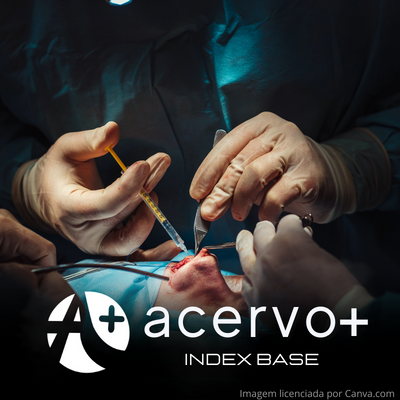Pós-operatório de cirurgia estética eletiva com evolução para Covid-19: um relato de caso
##plugins.themes.bootstrap3.article.main##
Resumo
Objetivo: Relatar o caso de uma paciente de 45 anos, pós-operada, submetida a cirurgia estética eletiva que evoluiu com contaminação por Covid-19 e infecção de ferida operatória na mama esquerda. Detalhamento do caso: A paciente recebeu, inicialmente, corticoterapia em decorrência das alterações de desidrogenase lática (DHL), proteína C reativa e plaquetograma. Além disso, a dessaturação (80%) teve como conduta médica a adoção de ventilação não invasiva (VNI) precoce com máscara de oxigênio a 10 l/min. Indicado e mantido antibioticoterapia devido à persistência da febre, infecção na ferida cirúrgica e no cateter venoso central. A paciente evoluiu com piora respiratória e infecciosa, encaminhada para assistência em terapia intensiva sob ventilação mecânica. A alta hospitalar ocorreu após desmame de oxigênio, estabilização da respiração em ar ambiente e exames laboratoriais e de imagem em níveis compatíveis com a normalidade. Considerações finais: Em suma, faz-se notório o caráter informativo trazido por esse relato de caso, principalmente por conta da experiência inédita e ainda subjetiva da doença Covid-19 e seus impactos na saúde humana, especialmente em pacientes vulneráveis.
##plugins.themes.bootstrap3.article.details##
Copyright © | Todos os direitos reservados.
A revista detém os direitos autorais exclusivos de publicação deste artigo nos termos da lei 9610/98.
Reprodução parcial
É livre o uso de partes do texto, figuras e questionário do artigo, sendo obrigatória a citação dos autores e revista.
Reprodução total
É expressamente proibida, devendo ser autorizada pela revista.
Referências
2. AMINIAN A, et al. Surto de Covid-19 e prática cirúrgica: fatalidade inesperada no período perioperatório. Annals of surgery, 2020; 272(1).
3. BRASIL. Diretoria Colegiada da Agência Nacional de Vigilância Sanitária. Resolução-RDC n° 36. 2013. Disponível em: https://bvsms.saude.gov.br/bvs/saudelegis/anvisa/2013/rdc0036_25_07_2013.html. Acessado em: 2 de fevereiro de 2021.
4. BRITO BL, et al. Covid-19: Como proceder na prática da cirurgia plástica no Brasil. O que sabemos até agora? Revista Brasileira de Cirurgia Plástica, 2020; 35(4): 449-65.
5. CABRAL LG, et al. Racionalização de antimicrobianos em ambiente hospitalar. Revista da Sociedade Brasileira de Clínica Médica, 2018; 16(1): 59-63.
6. CARELLI GZ, et al. Alterações laboratoriais em pacientes com Covid-19. Research Society and Development, 2020; 9(12): 1-19.
7. DOGLIETTO F, et al. Fatores associados à mortalidade cirúrgica e complicações entre pacientes com e sem doença de coronavírus 2019 (Covid-19) na Itália. JAMA Sugery, 2020; 155(8): 1–14.
8. FERREIRA FR. Cirurgias estéticas, discurso médico e saúde. Ciência & Saúde Coletiva, 2011; 16(5): 2373-2382.
9. FLEURY MK. A Covid-19 e o laboratório de hematologia: uma revisão da literatura recente. Revista Brasileira de Análises Clínicas, 2020; 52(2): 131-7.
10. FRANCO D, et al. Uso de antibióticos em cirurgia plástica. Revista da Sociedade Brasileira de Cirurgia Plástica, 2006; 21 (2): 112-115.
11. LÓPEZ-SALVIO YM, et al. Dímero D: papel em patologia trombótica. El Residente, 2018; 13(1): 12-22.
12. MAGALHÃES CM, et al. Adesão ao checklist cirúrgico para a segurança do paciente: percepção da equipe de enfermagem. Revista Eletrônica Acervo Saúde, 2021; 13(7).
13. MARTIN PS, et al. História e Epidemiologia da Covid-19. ULAKES Journal of Medicine, 2020; 1: 11-22.
14. PEREIRA AL, et al. Uso sistêmico de corticosteróides: revisão da literatura. Medicina Cutánea Ibero-Latino-Americana, 2007; 35(1): 35-50.
15. POGGIALI E, et al. Lactate dehydrogenase and C-reactive protein as predictors of respiratory failure in CoVID-19 patients. Clinica Chimica Acta, 2020; 509: 135-38.
16. PRADO AR, et al. Uso da Técnica Limpa ou Estéril em Curativos. Journal of Health Sciences, 2016; 18(3): 217-22.
17. PRATES CG, et al. Comparação das taxas de infecção cirúrgica após implantação do checklist de segurança. Acta Paulista de Enfermagem, 2018; 31(2): 116-22.
18. SCHULMAN S, et al. Venous Thromboembolism in Covid-19. Journal of Thrombosis and Haemostasis, 2020; 120(12): 1642-53.
19. SILVA RCL, et al. Utilidade clínica de analisadores de ensaio D-dímero Point-of-care para exclusão de tromboembolismo pulmonar em pacientes com Covid-19. Global Academic Nursing Journal, 2020; 3(1): 1-13.
20. SIQUEIRA LO, et al. Fármacos com potencial terapêutico para tratamento da Covid-19. Brazilian Journal of Health Review, 2020; 3(6): 17324-43.
21. XAVIER AR, et al. Covid-19: manifestações clínicas e laboratoriais na infecção pelo novo coronavírus. Jornal Brasileiro de Patololgia e Medicina Laboratorial, 2020; 56: 1-9.
22. YANG L, et al. Covid-19: imunopatogênese e imunoterapêutica. Signal Transduction and Targeted Therapy, 2020; 5(1): 1-8.

